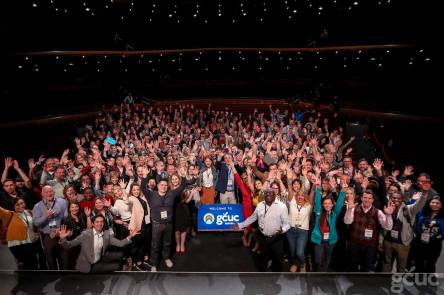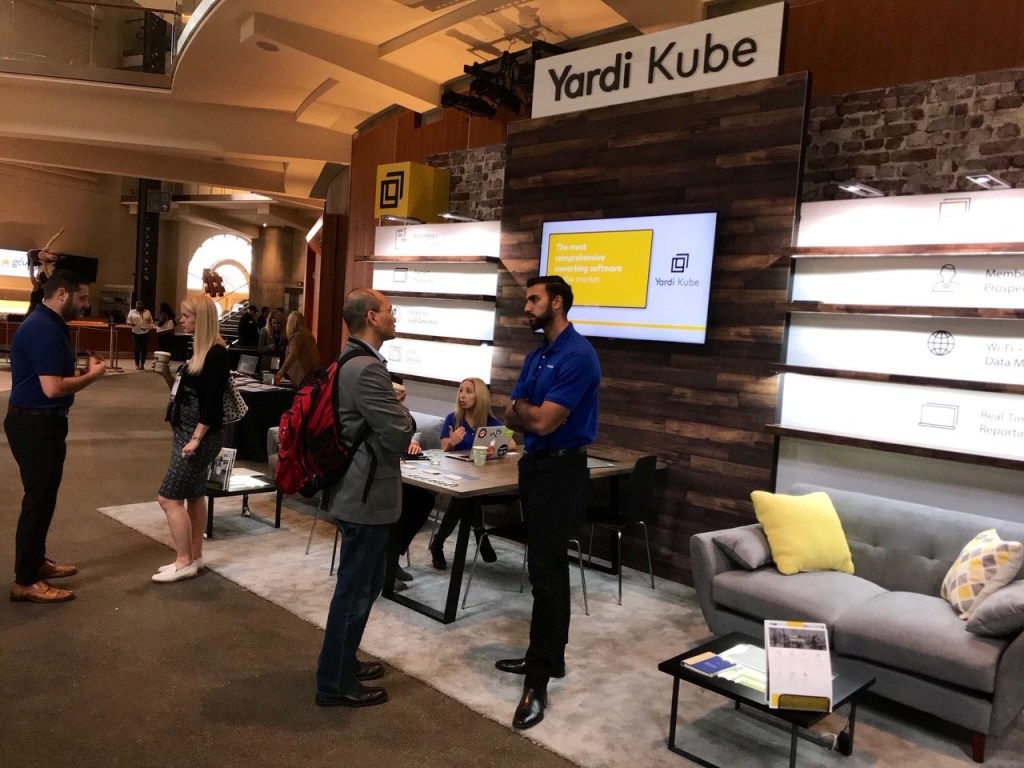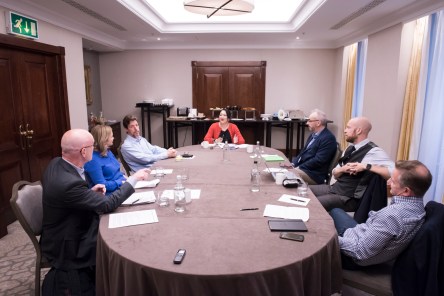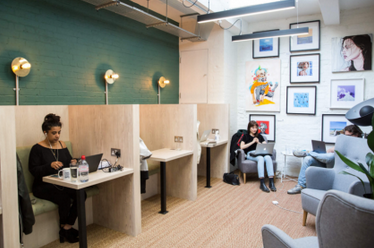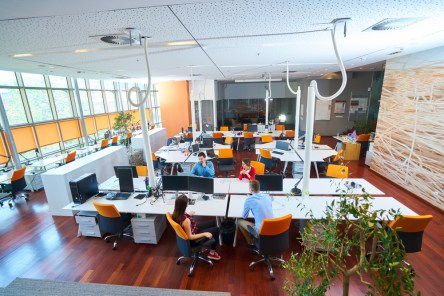Yardi contributed hugely to the success of the recent Realcomm ׀ IBCon conferences, an annual premier event in the commercial real estate industry, by showcasing innovative technologies that control revenue and expenses. Yardi focused on the benefits of Yardi Elevate, Yardi Kube and Yardi Pulse. These product suites blend business intelligence from Yardi Matrix with operational tools into a single connected platform that harmonizes leasing, deal management, tenant improvements, budgeting, construction management and other operations. Property owners can make better decisions, manage pipelines more efficiently and foster closer interaction between external brokers and asset managers. Rob Teel, Yardi senior vice president of global solutions noted in a live-streamed interview during Realcomm ׀ IBCon that property managers must manage revenue and expenses more actively than they did a decade ago to generate expected returns. “Success comes when teams work together to create an ecosystem of users who can collaborate to improve operational performance,” he said. Watch the full interview below: The solutions also give rise to new revenue streams from coworking membership arrangements, better forecasting capability, lower energy consumption and expenses without sacrificing occupant comfort, and budget and schedule certainty for construction projects. With their real-time connection to the Yardi Voyager property management and accounting database, they’re easier to use and more reliable than point solutions. “Yardi has extended solutions from the Yardi Voyager property management and accounting platform to encompass other elements, making property owners and managers more efficient,” Brian Sutherland, industry principal of global solutions, said in another live-streamed interview. Watch the full interview below: “Realcomm ׀ IBCon was a great opportunity for the Yardi team to connect with and learn from clients, vendors and other industry participants. The conference’s quality is second to none,” Teel said. Asked the secret of Yardi’s success, Sutherland said,...
Coworking Outlook
Changing the tech landscape
Editor’s note: this coworking perspective piece was authored by Justin Harley, regional director of coworking for Yardi, in association with Property Week. Harley was a co-founder of the flexible workspace management software Hubcreate. He joined the Yardi UK team in May. Having spent most of my career in the flexible workspace sector, I could not be more enthusiastic about how bright the future is for coworking and flexspace, and furthermore I am delighted to see technology and software leaders such as Yardi investing heavily in technology to fuel the growth and development of the sector. I have been privileged to see the coworking and flexspace sector grow from a few London-based serviced offices to what it is today, one of the fastest-growing parts of the real estate world. That said, it still only accounts for 4% of all deals in London, according to the latest research from Cushman & Wakefield and Colliers International. While real estate continues to develop an understanding of the coworking market, the industry is still a little shell-shocked about how it has crept up on them. That part of the real estate sector often misses the point when they debate coworking. I hear “we are not coworking, coworking doesn’t make money – when will the bubble burst?” Larger operators account for less than 13% of the market in the UK and the flexspace and coworking community is made up of businesses that care about innovation, member experience and the effect of their service on worker wellness. In short, it’s all about the customers and what makes them happy. Their obsession for customer service is what drives the industry. A happy client is a loyal client and, despite being on a flexible license, will stay for a long time. It is...
GCUC Recap
Coworking Conference Insights
Last month, Yardi Kube was introduced to the coworking world at the Global Coworking Unconference Conference (GCUC). The U.S. edition of the annual event was held in Denver from April 15-18. This popular coworking industry gathering provides attendees with extensive in-depth sessions with experts in the coworking space, educating them on financing, technology, community building, and branding. The first day of the event was a deep dive into especially hot topics for the coworking industry. Industry hot topics: making money Led by Jerome Chang of Blankspaces, the finance discussion focused on the number one way to make money as a coworking operator – through lease incentives. Fundraising methods for shared space startups include venture capital funding, personal loans, investment from friends and family members, and other avenues, but Chang shared that SBA loans for such businesses are unlikely. The average traditional office space will have about 165-185 square feet per employee. In a coworking space it could be as low as 50-70 square feet. Coworking operators can book common areas at up to 150 percent capacity, because your space won’t always be full (this uses the same logic as a gym membership: it’s possible to overbook because not everyone works out simultaneously). The biggest moneymaker, however, will be meeting rooms. They’re priced higher per hour than any other amenity or space in and should be rentable to the general public, as well as members. Virtual memberships provide a low-cost entry to members wanting to try out the industry. While individually, these memberships won’t be a primary source of income, it is a source of unlimited potential with no space restrictions. The Blankspaces model allocates 35-50 percent of space to private offices, Chang shared. And it’s important to make over 70 percent of your total available square footage...
Shifting Spaces
Office Market Update
While industry fundamentals are healthy and the economy is strong, the U.S. office sector faces pressures that could fundamentally alter its business model. Jeff Adler and Jack Kern, vice president and director of institutional research, respectively, for Yardi Matrix, provided an update on a sector in transition in a recent webinar. After a shaky fourth quarter of 2018, the U.S. economy has rebounded into “really good shape,” Adler said, with a rising stock market and inflation that is largely held in check by increased domestic oil production. The labor market is very tight—the best in 50 years, he said—with office-using sectors outpacing overall job and wage growth over the past five years and most markets absorbing available office space. Metros such as Dallas, Houston and Atlanta are growing fast and adding office-using jobs. Other locations with job growth and low unemployment, such as Orlando, Fla., Nashville, Tenn., San Francisco and the nearby Bay Area, have to import workers to meet staffing needs. Most markets still have room to absorb office space. In short, the industry is in a good place, and if the federal government’s pro-growth policies outweigh its anti-growth ones, “the party goes on,” Adler said. So what are the challenges? One of the main secular (long-term) factors is coworking, which pulls 1-3% of market demand from traditional office leases and keeps growing as companies expand beyond their primary locations. The practice is growing everywhere and won’t likely go away anytime soon, Adler said. Per-employee square footage is decreasing, particularly in central business districts and high-cost metros. With a tight labor market, companies are luring talent by making office “an experience-driven sector,” similar to what has happened in retail, incorporating design elements and attractions such as new technology, spaces for relaxation, natural light,...
Flexible Workspace
Topic of Yardi Think Tank
Yardi assembled a panel of flexible office experts to discuss the importance of a service ethos, how workspace providers can stand out from the competition and why the sector looks well placed to weather a possible recession. Panelists Gareth Evans, chief executive of BizSpace Katrina Larkin, co-founder of Fora Cal Lee, founder of WorkThere William Newton, president of Wiredscore Katie Whell, managing director at Pure Offices Tony Freeth, director of coworking at Yardi Simon Creasey, features editor at Property Week (chair) Flexible workspaces have been hailed as the future of offices, but as the business model continues to mature many questions arise about what this future might look like. To debate what lies ahead for flexible workspaces, Yardi put together a panel of some of the industry’s heavyweights. SC: How important is customer service for the coworking industry? GE: Customer service is what it’s all about. It’s quite interesting as a concept because one person’s customer service is another person’s lack of service. It depends on where you are regionally, what kind of centre you’re in and what people’s needs are. You can provide frothy coffee or whatever, but if that’s not what the customer wants then you’re not providing good customer service. KL: Myself and [Fora co-founder] Enrico [Sanna] come from a hospitality background, not from a workplace background. So, for us, customer service is absolutely key. We have worked with one of the top hospitality schools in Switzerland to attract the best people from the hospitality industry. WN: Before WiredScore moved into WeWork, we were with a provider who clearly hadn’t yet got what service meant. Their front of house people were security people trying to prevent people getting into the building who shouldn’t be there rather than welcoming in guests who...
Introducing Yardi Kube
Single Platform Coworking Solution
Yardi Kube™, a single platform solution for coworking and shared workspace operators, is now available. Introduced this week at the GCUC conference in Denver, Yardi Kube is designed to help coworking operators successfully grow their businesses, eliminate third party integrations, save time and offer competitive member services. With the powerful Yardi Voyager property management platform as its foundation, Yardi Kube combines accounts payable, general ledger, merchant services and more in one easy-to-use technology suite. Yardi Kube includes comprehensive accounting, online marketing integration and powerful reporting capabilities. Users will be able to easily report to owners and investors and market to new clients, all from within the platform. The member portal gives coworking members the ability to manage their profile, connect with other members, pay bills, purchase services and book space with one click. Yardi Kube can also handle management of Wi-Fi and VOIP systems. “We chose Yardi Kube because of its robust capabilities to manage our businesses. The fact that Yardi was behind the development gave us confidence in its reliability and development path,” said Willie Gutierrez, COO and CFO of Premier Workspaces, a nationwide shared workspace provider. “Yardi Kube is the long-awaited technology solution that will allow shared workspaces to scale and grow with ease,” said Dale Hersowitz, vice president of coworking at Yardi. “It maximizes efficiency, eliminates leakage and allows for real-time reporting, all in a single platform.” GCUC, which concludes tomorrow, is the world’s largest coworking event, with conferences held in five continents. About 300 attendees convened in Colorado for the event. At GCUC, the Yardi Kube team has been conducting demos of the new platform and sharing the product’s exciting features, including the accounting platform, internet listing service and prospect lifecycle tracking. “We look forward to showing the extent of Yardi’s commitment to coworking, what the future looks like for Yardi Kube, and how the platform separates itself from the competition,” said Dale Hersowitz, vice president of coworking at Yardi. GCUC attendees are invited to come by the Yardi Kube booth, #10-11, to see Yardi Kube in action. Visit yardikube.com to learn more about the benefits of an all-in-one coworking management solution for shared...
Australia Explores Coworking
Shared workspace practice expands
As coworking continues to gain traction in office markets around Australia, Neal Gemassmer, Yardi vice president of international, looks at the top three tech trends helping landlords stay ahead of the curve. This post is reprinted with permission and originally appeared in Property Australia. More coworking space in Australia was leased in 2018 than in the previous three years combined, finds recent research from JLL. Sydney and Melbourne accounted for nearly two-thirds (60%) of all coworking space – or 95,700 sqm – leased since 2015, JLL has found. But Australia’s other capitals are also jumping on board the coworking juggernaut. Meanwhile, Colliers has recorded a 46.9 per cent increase in flexible workspace in Sydney’s CBD last year. Although, with this representing just 2.44 per cent of the market, coworking is still in its early days. Gemassmer says Australia’s large office landlords are well placed to stay ahead of the curve if they embrace the right technology. He says three tech trends are at the heart of any successful coworking strategy. Know your customer with a CRM Every coworking space should have a customer relationship management system, or CRM in place, Gemassmer says. “A CRM will streamline lead entry, customer lifecycle tracking, vendor relationship management and a host of operational tasks – driving efficiency, enhancing productivity and ultimately leading to greater profitability.” Streamline systems with automated billing Whether you operate one space or multiple locations, automated billing is one of the most vital tech components to success, Gemassmer says. “Manual entry, regardless of how meticulously done, can create leakage – and this problem is worse when you’re a multi-space operator. “Operators who streamline their business with automated billing – particularly when done so alongside other tech-driven solutions – can offer the same product, but at a higher margin and lower cost.” There are software options which combine an accounting package with merchant services, such as the Yardi KUBE, which has a full general ledger suite and accounting package, Gemassmer explains. Let’s get connected “Not all coworking enablers are tech-driven,” Gemassmer observes. “Hosting after-hours events, creating sports teams or designing spaces to encourage incidental interaction are among the many ways to build a coworking community. “But ultimately, most coworking members spend their day sitting behind a screen, and this means tech plays a central role in building and enhancing that sense of community. “Yardi’s member portal helps members book meeting space, connect with an online marketplace, access special deals and pay invoices in just a few clicks. People may be attracted to coworking for its collaborative potential, but it will be the seamless technology experience that keeps them.” The new Yardi KUBE platform allows operators to seamlessly manage their coworking space operations and financials in a fully-integrated platform while providing a phenomenal member experience. Learn...
Key Features
For Coworking Software
As an operator of a coworking space, you’ll have many choices when selecting a management platform to power your shared workspace. Compare pros and cons and check what features each choice provide, but make sure these five features are included in your software. Robust Accounting Accounting is a vital component to the operation of your space. You may choose a software that integrates with third party applications such as Quickbooks, FreshBooks, or others. That is a significant step up from manual labor. In a perfect world however, your management platform would have all accounting solutions built in. This will eliminate third party apps for accounts payable, payment processing, merchant services, and reconciliation, among other functions. ILS There are numerous benefits to having an ILS (internet listing service) built into your coworking management software. List your space and eliminate marketing time and dollars. Potential members can check out your space at a glance, and improve the quality of your leads. In addition, you will greatly benefit from the ability to sell your services online in real time. Offer spaces, services, and just about anything else you can list. Keep track of sales and revenue live. Real-time Reporting Real-time reporting goes beyond just statistics. Being able to track data and results live will help you track sales, revenue, space usage, and many more driving factors of the success of your space. At the end of the day, the goal is to increase your revenue and provide better service to your members and guests. Real time reporting is at the core of all those goals, as you’ll have visibility to change membership plans, designs, and service based on tracking data over periods of time. Learn more about the benefits of CRM and automated booking in your coworking management software on the...
Member Personas
For the coworking space
One of the most critical aspects to properly marketing your coworking space is building member personas. You could be doing tons of hard work and spending time and dollars on marketing, but if you’re not aiming at the right target, it could be all for nothing. Let’s take a look at how and why to build member personas. What are member personas? Imagine creating your ideal member, in detail. Consider what characteristics, habits, demographics, and many other factors formulate the member you would most associate with your space. For example, you could say ‘Tom’ is an entrepreneur, based in Miami, age 34, losing creative spark due to isolation, and needs to work a flexible schedule due to other demands. Tom is your target customer. This guide is a good way to check off the questions you need answered, so that you’re not just marketing to “everyone.” But why can’t you just target a wide scope and range of potential members? You’re bound to hit on some of them, yes, but for the most part this isn’t a prudent strategy. You’re going to be wasting your efforts targeting lots of personas that simply don’t match with what your space is all about. If your scope is too wide, your space will be too formal for some, too informal for others. It may be too large or too small. It may be out of driving distance. It may be out of budget. An important note from coworking marketing expert Cat Johnson is that your potential member can get a desk and Wi-Fi in many places. Make sure you are targeting someone who needs more than that, be it intangible features like community and collaboration, or tangible benefits like conference rooms and after hours access. Learn how to create...
Must-Have 2019 Tech
For the coworking space
While the coworking industry continues to expand, its important to keep up with the best new technology. Let’s take a look at some of the most latest critical tech components for coworking spaces. CRM Every coworking space should absolutely have a CRM in place. It is truly one of the most integral components to a modern thriving workspace. Not only does it assist in lead tracking, but a CRM will improve your relationships with your current and prospective members. A CRM will streamline lead entry, customer life cycle tracking, vendor relationship management, and many other operational tasks. It drives efficiency and will enhance productivity, and directly leads to greater profitability. The technology-driven corporate world we live in today demands a CRM. According to a study by Gartner, CRM will be the single largest revenue area of spending in enterprise software by the year 2021. Not only is the CRM going to be a core tool for sales and marketing, but it will also benefit customer service. Since your members are reaching out via social media, phone, chat, email, and any other method they can find, it’s important to consolidate all their interactions in one place. The uses of a robust CRM are virtually limitless for all aspects of a successful coworking space. Automated Billing Whether you operate one space or multiple locations, automated billing is a vital component for success. Consider the time you’re spending balancing and reconciling your books. Consider the outsourced cost if you hire a bookkeeper. With the market becoming more competitive, shared space supply is increasing, and organized operators can run more efficiently. In many cases, operators streamlining their business with automated billing (among other tech solutions) can offer the same product at a more competitive cost. Standout softwares combine an accounting package with merchant services. Yardi KUBE...
Yardi KUBE Preview
New, Single Platform Explained
Ed. Note: WUN KUBE has joined the family of Yardi property management software. KUBE provides a suite of technology products for coworking and shared space management. This piece on the new platform originally appeared on the KUBE Blog. As we approach the much anticipated release of the new Yardi KUBE platform, we conducted a client-exclusive Q&A session to address a variety of topics. The response was overwhelmingly positive and we cannot wait to debut the new KUBE. We will beta launch in January 2019, and full roll-out is set for April. Below, we’re going to summarize some of the main talking points from the recent webinar. What are the main changes for KUBE? It’s tough to put into words exactly the incredible extent to which Yardi is impacting our platform, but we tried to do so again in the webinar. Dale Hersowitz, our VP of Coworking, explained that Yardi is best known for building software for the real estate industry, from commercial to multiunit to many other facets. They are now fully diving into the Coworking world with the acquisition of WUN last year. The most important change for KUBE is essentially putting together a single stack. What does that mean? Yardi has a full general ledger suite, an accounting package, they’re also a merchant, they offer a vendor procurement solution, they are an e-broker, and KUBE will continue to provide the operational component to power your day to day functions of your space. No more third-party integrations. Yardi will encompass 7 modules in one tightly integrated solution. Everything in a single platform allows for greater efficiency, cost savings, prevents leakage, and enables operators to scale effectively. Enhancements and New Features The attendees asked several questions regarding the enhancements of the new platform. Yardi has a...
Sharing Disruption
U.S. Coworking Expands
Coworking isn’t new, but its recent growth and prominence in the U.S. office market space is. A new special report from Yardi Matrix, titled “Shared Space: Disrupting the Traditional Office,” outlines the dramatic increase in shared spaces over the past year, driven by a growing “gig economy” and employers’ desire to deploy more workers remotely, attract talent and gain more flexibility for their space. In researching 20 metros, Yardi Matrix found that 43.5 million square feet of office space was being rented as of the fourth quarter of 2018. This represented a 62% increase in shared space over the previous year and 1.7% of the total inventory. The business model for shared space is evolving to match the practice’s growth, with landlords and brokerage firms offering more amenities and flexible lease arrangements. Coworking has gained footholds in both urban markets (2.2% of stock) and suburban submarkets (1.2%). The practice is “growing as a percentage of office stock in all areas, but it is a more natural fit in urban settings due to the proximity to a greater number of workers, easier commute to urban locations and greater availability of small rental spaces in suburban areas,” the report says. “The sector is in a nascent phase, so the pace of growth is likely to pick up in coming years.” Manhattan, N.Y., ranked first in both overall amount of shared space with 13.7 million square feet, with Los Angeles second with 4.7 million square feet. The borough also had the most shared space as a percentage of total stock, 3%, with Portland, Ore., Miami, San Francisco and Austin, Texas, totaling 2.5%, 2.4%, 2.3% and 2.2%, respectively. Read the full Yardi Matrix special...
Coworking Revolution
Becoming mainstream in UK
Increasingly, companies don’t have a five-or 10-year vision based around a particular space with a particular staff mix. They want short-term arrangements where they can flex their head count and floorspace up or down depending on need. This applies to businesses both large and small. While coworking once meant an office for four to six people, today deals are being signed for spaces that will accommodate 25, 50 or even 100 staff. Coworking also helps firms to retain the best employees by providing them with a stimulating and collaborative working environment. Sitting behind all of this is new technology which means that operating or using a coworking space is more streamlined than ever before. But with so many coworking spaces springing up, competition is getting ever more intense. So what can operators do to make their schemes are a success? Businesses today are looking for more than just a desk, a telephone and an internet connection – they want a level of service on a par with what you would expect in a high-end hotel. Years ago, we used to call the people sitting in the entrance ‘receptionists’, but today we refer to them as ‘front-of-house.’ In a successful coworking space they should engage with members, know them by name and be on hand to manage all aspects of the customer experience. Technology is a big part of this. A fast, reliable internet connection is crucial to most businesses and Yardi’s software means access to spaces is seamless, so when a member enters a coworking space they are instantly recognised and connected to the wifi. This can even work across multiple coworking locations. Unlike more traditional companies where most staff leave the building between 5pm and 6pm, some companies operating out of coworking spaces...
5 Tips for Client Retention
At Coworking Spaces
Today’s entrepreneurs and remote employees have several workspace options, often including the comfort of their own homes. To attract and maintain clients, transform your coworking space into a unique destination with a welcoming community. Offer Top-Notch Security Clients want their shared workspace to feel safer than their local coffee shop or home office. 7 Tips for Improved Security can help you establish a place where clients, their possessions, and their data are secure. Ensure that your security software is accompanied by human backup. For example, post a phone number that clients can contact if the door access control is ever on the fritz. Such measures will help clients feel supported in an increasingly automated world. Continuing Education Experience-driven spaces are the latest in office design. Continuing education events offer new experiences for clients. The classes also double as a value-added service. You may want to: Host how-to workshops for popular software programs Invite experts to facilitate theme-based seminars, such as marketing and project planning Create member forums where clients can network Seminars on work-life balance techniques and relaxation methods Create Thoughtful Ambiance Thoughtful design pays off. Your design can inspire your clients, enhance the atmosphere, and promote client wellbeing. Each feature defines your space as a desirable and valuable destination. Add indoor plants to help cleanse the air while combatting the sterile office vibe Opt for sustainable office supplies, which are popular with young professionals Mix up your seating with a combination of conference-style tables as well as private nooks Create different work environments with varied lighting in different rooms or regions of the workspace Consider placing white noise machines in conference rooms for privacy Build Community through Experiences Many clients will opt for a shared workspace because of the potential for social interaction. Fulfill their expectations with community-building tools and activities. Consider: Games, both digital and real-world Indoor rock climbing Yoga classes Live music Mini massages and acupuncture Sports tournaments The right activities for your community depend on how your space is divided. Use your best judgement to establish an engaging yet professional atmosphere. For new workspaces, it may be difficult to gauge your clients’ interests. Consider polling members on what activities they’d like to have on site. Satisfy Bellies In addition to coffee, get creative with your treats! Some clients use snacks as a way to take a break. Others will snack when they can’t take a break for a real meal. Save the day by offering a combination of fun, quick, and nourishing treats. Hot cocoa bars with a variety of toppings Cupcake stations add cheer (and a sugar rush) to any slow afternoon Build-your-own trail mix bars are a simple and healthy way to jazz up the snack scene Quick, customizable lunches (think hotdogs and burgers) are an inexpensive and easy way to show client appreciatio Built-in Marketing These suggestions can transform your coworking space into a unique destination with a welcoming community. They come with an additional bonus: free marketing. Fun features create opportunities for clients to post photos on social media. Be sure to have your social media handles posted throughout the office so that they can tag your...
UK Think Tank
A Coworking Conversation
The evolution of the flexible office sector has shaken up the real estate industry and has arguably changed it for the better. Yardi recently brought together a panel of experts in the UK to discuss the many segments of flexible offices and what lies in store for the sector. Mary Finnigan, head of transactions, real estate, WeWork Chris Pieroni, operations director, Workspace Group Adrian Goldney, co-founder, Flexible Office Space John Williams, head of marketing, Instant Group Joff Sharpe, head of operations, British Land Tony Freeth, director coworking, Yardi Europe Liz Hamson, editor, Property Week – chair LH: With all the different definitions out there, what should we be calling the sector? Should there be a standard definition or does it really matter? CP: All the definitions out there are very different – hybrid, coworking, flexible, service – and then you’ve got all sorts of issues around whether they are an operator or a landlord and then you’ve got all sorts of issues about what sort of services are offered; whether they are exclusive or not. And it’s really complicated to pull all the data together and try to get an understanding. I’ve got my own view on where we stand in the flexible office market and we didn’t fit into any of the definitions. We’ve decided to just look at the flexible market. LH: So what do you define flexible as? CP: So we had three different categories – something under three months, and then we stopped at over 12 months. But actually, I think now as larger corporates want flexibility, you might be saying flexibility for them is three years. So I don’t know, but we stopped at over 12 months. JS: I don’t think the starting point is flexibility; it’s...
Coworking Security
7 Ways to Keep Everyone Safe
As the manager of a coworking space, you walk a fine line. Your site must offer security while helping members and guests feel welcome. The following seven tips promote digital and physical security without interrupting ease-of-use. Create a Warm, Automated Welcome Automated attendance trackers deliver convenient yet controlled access to your shared workspace. Combine Kisi and KUBE door access systems to manage member and visitor logs as well as billing details. There is no need to have users register and pay for common use areas in advance. Users pay as they go, minimizing cancellations and billing disputes. As an added convenience, any user with a mobile device can begin working automatically. With access and billing aside, your reception staff can focus on welcoming clients, answering questions, and placemaking. Offer Private Wi-Fi As an alternative to shared wi-fi networks, private networks provide excellent digital security. Each user receives a unique code that doesn’t overlap with fellow users’ access. Consider linking access with membership. A single code issued to all members and guests does not provide the protection you need. Link access codes to users’ unique membership level as an additional layer of security. Have that code expire with the membership or expire after a certain duration of time for guests. Switch Up Guest Access If individualized wi-fi credentials for guests seems tedious, consider a simple guest wi-fi network and password. For added security, update log-ins at least every quarter, if not every month. Encourage Privacy with Filters Install an IP filtering system that can minimize undesirable data sharing and burdensome traffic loads. Not all data theft occurs digitally. Applying privacy screen filters on your in-house computer monitors limits the access of wandering eyes. Benefit from Member Education Education is key to risk mitigation. During new...
Coworking Takes Off
Asia market update
The global wholesale leasing model is under pressure, as technology-enabled coworking gains both momentum and market share, says Neal Gemassmer, vice president of international sales for Yardi. Shared workspace is not new – but advancing technology, the growing gig economy and cost-cutting strategies are driving the coworking trend into the mainstream. Increasingly, corporations are turning to coworking to accommodate remote employees, attract talent, promote work satisfaction and reduce leasing costs. “Technology-enabled coworking is undoubtedly putting pressure on traditional leasing models,” Gemassmer says. “Developers of A Grade office buildings have traditionally acted as wholesalers of whole or half floors of space to occupiers who must make long-term leasing commitments, and then fit out their own offices. “But technology-enabled coworking operators are using online marketing and leasing systems to efficiently offer office space to tenants at competitive rates. This is beginning to encroach on the territory of office developers. “Changes to technology does more than change behaviour. It changes the environment itself.” Gemassmer points to a recent report from Asian market intelligence source Mingtiandi, developed in partnership with Yardi, which found the growth rate of coworking in Asia had hit 40 percent in 2017. Starting as a single coworking space in New York in 2010, WeWork is one lease away from being the biggest landlord in the Big Apple. With 280-plus locations in 20 countries, WeWork is rolling out roughly 185,000 sqm of new office space every month. Around a quarter of WeWork’s clients are enterprises with more than 1,000 employees. WeWork only launched the enterprise service in 2016, and has since amassed an impressive list of clients including Facebook, Airbnb, Microsoft, Adidas, Amazon, Starbucks and LinkedIn. WeWork is just one of several coworking companies taking the region by storm, but it is the biggest. In...
Flexible Workspace
Q&A with Tony Freeth
Editor’s note: The following interview originally appeared in GCUC UK and is reprinted with permission here. Tony Freeth has seen the evolution of the office space industry firsthand. Co-founder of Phoenix Broadband and creator of Medusa, a product that handles premises infrastructure, Freeth has played a pioneering role in bandwidth management and workspace wifi solutions since the late-1990s. Recently, Medusa was acquired by global real estate technology company Yardi. Freeth, who was at the first Global Coworking Unconference Conference (GCUC) in Austin, Texas in 2012, has now taken the role of Director of Coworking Europe at Yardi. With two decades of experience, Freeth provides a unique and valuable perspective on the now-booming workspace industry. We spoke with Freeth about the evolution of the industry, Yardi’s acquisition of Medusa, and how commercial real estate has now adopted coworking as an asset class. Here are the highlights of our conversation. What’s your coworking story, Tony? How were you introduced to what was then a small movement? Tony Freeth: In 2010, I was talking to someone at Steelcase who told me I needed to go to Coworking Europe. While there, I came across a bunch of people who had a very different idea of how people could work in a space, based on collaboration and community. We tried to sell that message to our conventional customers for many years, and for a long time their response was, “No that’s not what we do. Everyone wants a door.” We told them when you put millennials behind doors, it’s like depriving a plant of light—they just wilt. I met [GCUC producer] Liz Elam at Coworking Europe and she invited me to Austin for GCUC. It became clear that U.S. coworking seemed extremely vibrant and extremely well-organized. I imagine your...
New Coworking Trends
Tech's Important Role
When it comes to shared workspaces, we know technology is a major driving force. Today we look at some of the most important workspace technology trends shaping the coworking industry. The Internet of Things What is the IoT? Basically it is the connected amenities we use daily to send and receive data. The IoT includes physical devices such as virtual assistants, vehicles, appliances, smartphones, and just about anything else you can think of. Like this Forbes article suggested nearly 4 years ago, anything that can be connected, will be connected. What do we want in a coworking space? Smart connections. Building community. Enhancing relationships. The IoT improves the atmosphere and the benefits of a shared workspace. IoT powers meeting spaces, runs automated coffee machines, controls keyless access systems, promotes energy saving and much more. The uses of IoT are endless and only growing. By 2020, the number of connected ‘things’ is expected to reach 50 billion, and an estimated 99% of those ‘things’ can be further optimized. 94% of offices that chose to implement the IoT have already seen a return on investment. The future is only going to bring wider implementation of the IoT in shared workspaces. Mobilization Just about anything can be done via a mobile device today. And in the very near future, that ‘just about anything’ will become ‘literally everything’. Mobilization of our world is happening faster than any other aspect of our business lives. You can successfully run your coworking space from anywhere in the world via mobile phone, laptops, tablets, and more. This is allowing operators to work on expansion, design concepts, marketing, and many other aspects of running a workspace while the day to day running of the space basically runs itself. There’s so many coworking-relevant apps that it can be hard...
Pet-Friendly Work
Office Options for Furry Friends
Much ink has been spilled on the topic of Millennials and their influence on the modern workplace. This tech-savvy generation is willing to change tracks towards a more satisfying career path, and able to ride the rough waves of the gig economy. Millennials’ demand for a lively urban life is driving the revival of downtowns across the nation, and the development and expansion of a new office design plan: the coworking office. To go with this new office concept, employers are further trying to entice workers with a series of office perks that address the preferences and values of this generation. Office listings platform COMMERCIALCafé looked at one of the most recent additions to the growing range of work benefits―the option of bringing your pet to work―and compiled a list of the 50+ most pet-friendly coworking hubs in the U.S. Peruse the list below and read on for more details about the pros and cons of bringing pets to the office. The list is by no means comprehensive and remains open to suggestions. Among the venues that caught our attention is the whimsically named CO+HOOTS in Phoenix―recently acclaimed one of the most innovative coworking spaces in the U.S.―which invites visitors to meet the office dogs. Strongbox West in Atlanta―the city’s oldest coworking space―is not only a self-declared dog-friendly office, but a veritable ‘doggy daycare operation.’ The Box Jelly in Honolulu holds different events for owners and their pets, and they don’t shy away from welcoming unconventional companions. If you’re considering adopting a pet-friendly policy in your office, it’s good to weigh both pros and cons. There are several benefits of spending your workday with your beloved furry friend. For one, you can stop worrying about its safety and hurrying out the door as soon...
New Acquisition
Phoenix Broadband Ltd.
Yardi announced the acquisition of Phoenix Broadband Ltd., an innovative business technology firm specializing in infrastructure and hardware solutions for shared workspaces. Based in Stirling, Scotland, Phoenix Broadband is known for its Medusabusiness brand. Medusa is a service platform for managing technology resources in a shared workspace. When multiple companies share a common office space, access to secure, easy-to-manage technology is important. Centralizing access to cloud-based business networks, Internet, Wi-Fi, voice services and more, Medusa provides simple hardware and seamless IT for coworking spaces. “We are delighted to become part of the Yardi family, and through them, ensure Medusa is the leading network technology powering the boom of flexible workspace in the real estate industry,” said Tony Freeth, principal for Medusabusiness. “We believe our clients will benefit tremendously from Yardi’s investment in the future of coworking.” The team of 10 developers, help desk associates, sales and management team will continue to operate from its office in Scotland. Medusabusiness currently serves over 700 locations such as business centers, coworking spaces, real estate managers and IT firms, including more than 300 spaces in North America. “We are expanding our investments in the coworking arena.” said Gordon Morrell, executive vice president of Yardi. “Shared workspaces are a growing industry that bridges real estate and technology, areas that continue to be Yardi’s primary focus.” This is Yardi’s second recent acquisition in coworking technology. In late 2017, Yardi acquired WUN Systems, the Florida-based maker of a software management platform for coworking spaces. Many coworking spaces use both WUN’s platform and Medusa. Founded in 2002, Phoenix Broadband Ltd. is based in Stirling, Scotland. Serving the shared workspace market, clients include business centers, coworking spaces, real estate managers and IT firms. The company’s products deliver seamless IT management in shared workspaces....
Moving Mainstream
Coworking Picks Up Steam
No longer the sole domain of freelancers, micro busineses and start-ups, coworking is taking the Asia Pacific by storm as large companies jump on board the trend, says Yardi’s Neal Gemassmer. According to research by Cushman & Wakefield, coworking has accelerated rapidly throughout the Asia Pacific region, with roughly 750,000 sqm of space leased over the last two years alone. America’s largest coworking company, WeWork, now has 300 offices in 62 global cities, while China’s Naked Hub and Ucommune are also making waves around the region. Gemassmer, Yardi’s vice president for international business, says demand from corporates has been the one of the biggest coworking drivers. He points to research from Cushman & Wakefield, which finds the number of coworking enterprise-level companies – those with more than 500 employees – has doubled in the last 12 months. Meanwhile, the share of freelancers and independent workers has dropped by nearly 15 per cent over the last three years. “Large companies are on the hunt for space that is flexible, that enhances collaboration, and that fosters a creative culture – all characteristics of a coworking environment,” Gemassmer says. So, what are the three coworking trends to watch in 2018? Innovation acceleration “An innovation culture is an essential ingredient in a modern workplace, particularly as disruption continues to drive many companies out of business,” Gemassmer says. “Nurturing new ideas is critical to any company facing industry disruption.” Google has established community hubs, which it calls “campuses” to cultivate a community of entrepreneurs. Coders and creatives, innovators and investors can work together while locals catch up for coffee. Similarly, Unilever has set aside an entire floor of its regional headquarters in Singapore for start-ups to set up shop, and for its own team members to connect. “Coworking can...
Coworking in Europe
A few exceptional examples
Europe is a vibrant, culture-rich continent that combines world-class cities with future-focused professionals who are growing the coworking industry. As of 2016, there were over 2,500 coworking spaces throughout Europe, comparable to, if not exceeding, the amount in North America. Let’s take a look at 6 amazing coworking spaces in Europe, some in major tourist hubs, and some on roads less traveled. Volumes – Paris, France Paris needs no introduction. It is one of the cultural, historical, economical and tourist capitals of the world. In the center of the city you’ll find Volumes. What’s most unique about Volumes is that it combines coworking, a makers space, and a food lab. Makers Space is an onsite workshop fully equipped with a laser cutter, milling machine and a 3D printer (check out their website for details on this, it’s fantastic). The food lab is ideal for restaurant startups, amateur chefs, and anyone who wants to break into the culinary field. It is as unique a set-up as any coworking space Europe offers and in an amazing location as well. Remix – Paris, France Another top spot coworking spot in Paris is Remix. Remix boasts 5 locations throughout the city, all with ample space, huge conference rooms, multiple smaller meeting rooms, and kitchens. Their membership prices are posted directly on their site and they all provide 24/7 availability, which is huge. Work.Life – London, UK A major tourist destination, as well as a booming entrepreneur hub, London is home to some of the most unique coworking spaces on Earth. Check out Work.Life which has 6 locations in the city. Work.Life specializes in shorter term memberships and more intimate spaces, with hotdesk plans available even by the hour. For as little as £4 per hour, you can grab a...
Coworking Trends
Yardi Matrix Insight
Yardi Matrix has completed the first report that quantifies the amount of office space dedicated to coworking in office buildings with 50,000 square feet or more in 20 large U.S. markets. “Coworking represents a small yet growing segment of the office market,” the report says, noting that that 20 markets contain more than 1,100 coworking space encompassing almost 27 million square feet of space. This total represents 1.2% of the total office space in those markets. Shared workspace originated in the 1990s to provide space for self-employed workers and employees traveling or working remotely. The practice expanded after the Great Recession, driven by a growing gig economy, cost-cutting strategies and other factors. Today, the report says, “coworking represents a small yet growing segment of the office market” that helps companies accommodate remote employees, attract talent, promote work satisfaction and reduce leasing costs. Eleven of the 20 metros in the Yardi Matrix study have more than 1 million square feet of coworking space for lease, led by Manhattan, N.Y., with 7.65 million square feet in 245 spaces and the Los Angeles office space market with 3.7 million square feet of coworking space in 158 locations. Nine other metros have at least 1 million square feet dedicated to coworking. Miami has the most coworking space as a percentage of total stock, at 2.7%. “Demand is high in markets with concentrations of knowledge workers—especially IT but also new media or industries such as biotechnology and telecommunications—that are friendly to startups [and] in metros where space is at a premium,” the report says, and lower in metros such as Dallas and Houston that have low barriers to construction and high vacancy rates. The practice is more prevalent in urban settings due to the concentration of workers there and...
Coworking Trends
How Work is Changing
The year 2017 marked the largest growth in coworking, and produced all-time highs in number of spaces as well as number of members. As the industry grows and evolves, what are some of the major Coworking trends to look for in the next year? Here are five trends that will shape the continued expansion of coworking in 2018. Increasing Demand It’s estimated that 50% of the population will be working independently by 2020. If this comes to fruition, the demand for shared space will continue to rise at a fast pace in the next year. According to some estimates, there could be up to 37,000 Coworking spaces worldwide by the end of 2018. Those interested in joining the movement see that Coworking has become a symbol of community, connectivity, efficiency, and networking. Not to mention it’s a cheaper alternative than leasing in a traditional office space. The demand will only continue to increase in 2018. Health Another trend we could see in the coming year is the value placed on health, both mental and physical. Sure, we’ll continue to see the added benefits of some Coworking locations such as workout spaces and yoga classes. But mental health has been brought to the forefront and working from home, or even in some traditional offices, can create isolation, among other negative factors. Today’s society is searching more and more for the positivity of community, a huge benefit of coworking. Larger companies Coworking spaces tend to gear toward small businesses, freelancers, and entrepreneurs. However larger companies have started to pick up on the trend and realized the added value of working in cross-functional teams instead of in more traditional set ups. Not only does working within a coworking space offer corporations a more cost-effective alternative to test new...



